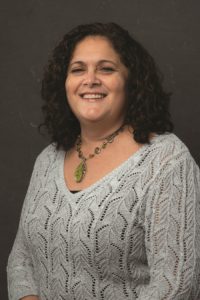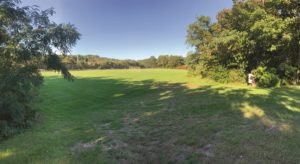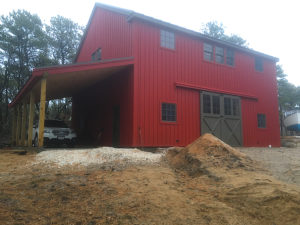EASTHAM — Katie Castagno and Natalia Redyk call it the “Cape Cod shuffle.” They’ve been doing it since landing jobs here nearly three years ago.

“We moved here to start my position at the Center for Coastal Studies in November 2020,” Castagno said. Soon, Redyk, a physical therapist, landed a job at Spaulding Rehabilitation Center’s outpatient facility in Orleans.
That fall, Castagno said, “We thought we would start looking for places to buy, but everything was out of our price range, so we decided to wait until January when prices usually come down.” But in January 2021, prices instead began to soar, as people turned rentals into year-round houses during the pandemic. Buying a house “became less and less of a possibility,” Castagno said.
Castagno’s parents, Anthony and Karen Castagno, built a house in Eastham in 1991 at 325 South Sunken Meadow Road. The family spent summers there, and now Anthony and Karen, who are retired, live there full-time. Meanwhile, their daughter developed an interest in the Cape’s unique ecology, which led her to a Ph.D. in geological oceanography through a joint program offered by M.I.T. and the Woods Hole Oceanographic Institution.
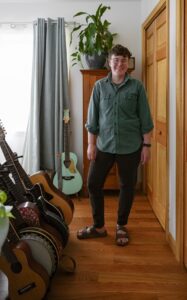
Katie said day camp at Audubon’s Wellfleet Bay Wildlife Sanctuary launched her on her career. “Basically, I get to do a lot of the things that I was doing in camp, exploring and enjoying the world around me,” she said.
She found her dream job, but finding housing was a nightmare.
“We lived at my parents’ house initially until we could find a seasonal rental,” Castagno said. The couple hopped from one seasonal rental to another over the next two years.
Meanwhile, Karen and Anthony decided to look into the possibility of building an accessory dwelling unit, or ADU, on their half-acre property.
It took two years to complete design, permitting, and construction, but the Castagnos got a certificate of occupancy for the 800-square-foot freestanding unit on July 1. Katie and Natalia moved in shortly thereafter.
Constructing an ADU is an expensive venture, and in this case it became even more expensive than the family anticipated when they were required to install a new septic system. But the Castagnos were able to get some technical guidance as well as a little financial help from the Community Development Partnership’s ADU resource center.
The resource center was launched in April 2022 with $1 million in American Rescue Plan Act funds. ADUs are added units built on existing residential properties. They can be converted basement spaces, apartments built over garages, additions connected to the main house, or detached structures.
Resource center staff have been working with the health and building departments on the Lower and Outer Cape to streamline the process by developing templates to make it easier for property owners to navigate the various requirements in their communities.
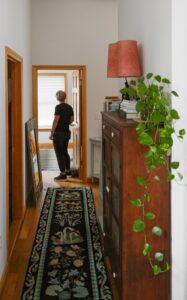
“Folks contact us, and we help them through the process: seeing what their zoning bylaws and all their setbacks are to see if it’s feasible for them to build an ADU — and can they do it by right or will they need a special permit,” said Terri Baron, the CDP’s director of program resources.
The resource center serves as a liaison between the town and the property owner.
The Castagnos needed a special permit from the town to build a detached ADU, said Karen. “We were limited to 800 square feet because one of the restrictions in Eastham is that the ADU can’t be more than half the square footage of the main house,” she said.
The resource center also offers $25,000 incentives to property owners who create ADUs, as long as they are rented year-round for five years. The money is a loan; once five years have passed, the loan amount is forgiven.
The Castagnos were the first to get a $25,000 award through the center, but interest is on the rise across the Lower Cape.
“People are becoming more curious about modular ADUs as more are being built,” said Talitha Abramsen, who manages the CDP’s housing resources program. Since the center opened a year and a half ago, more than 100 people have contacted the CDP for advice on building ADUs.

Jay Coburn, CEO of the CDP, said that there is no income requirement for prospective tenants. “One of the most challenging parts of addressing the housing affordability crisis in the region is that there are lots of different subsidy programs and resources available for units that are at 80 percent and below of the area median income, but only a tiny bit of money for those that are between 80 and 120 percent of AMI,” Coburn said.
Homeowners are also hesitant to put a restriction on their properties requiring that the ADU remain affordable, Coburn said. For that reason, the CDP decided to make the only restriction on the incentive money the requirement that the ADU be rented year-round for at least five years.
Tenants can also be family members, since many homeowners, like the Castagnos, are building units for their adult children who want to stay on the Cape but can’t find a place to live.
“There are folks we’ve talked to who are thinking about signing over or selling their main home to their adult children and aging in place [in the ADU],” Coburn said. “Our thought was it’s OK to build these for family members because, again, it’s keeping working people in our region.”
For Katie and Natalia, the ADU has lifted the constant worry over housing from their shoulders. “It’s really an incredible opportunity to be back here, working in an area that is so precious to me,” Katie said. “It feels very nice to have some stability in our housing.”

